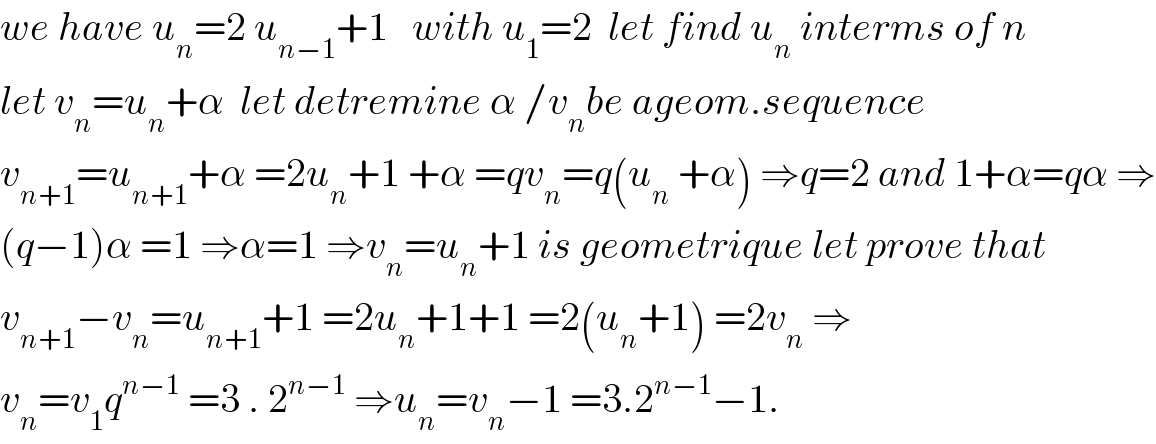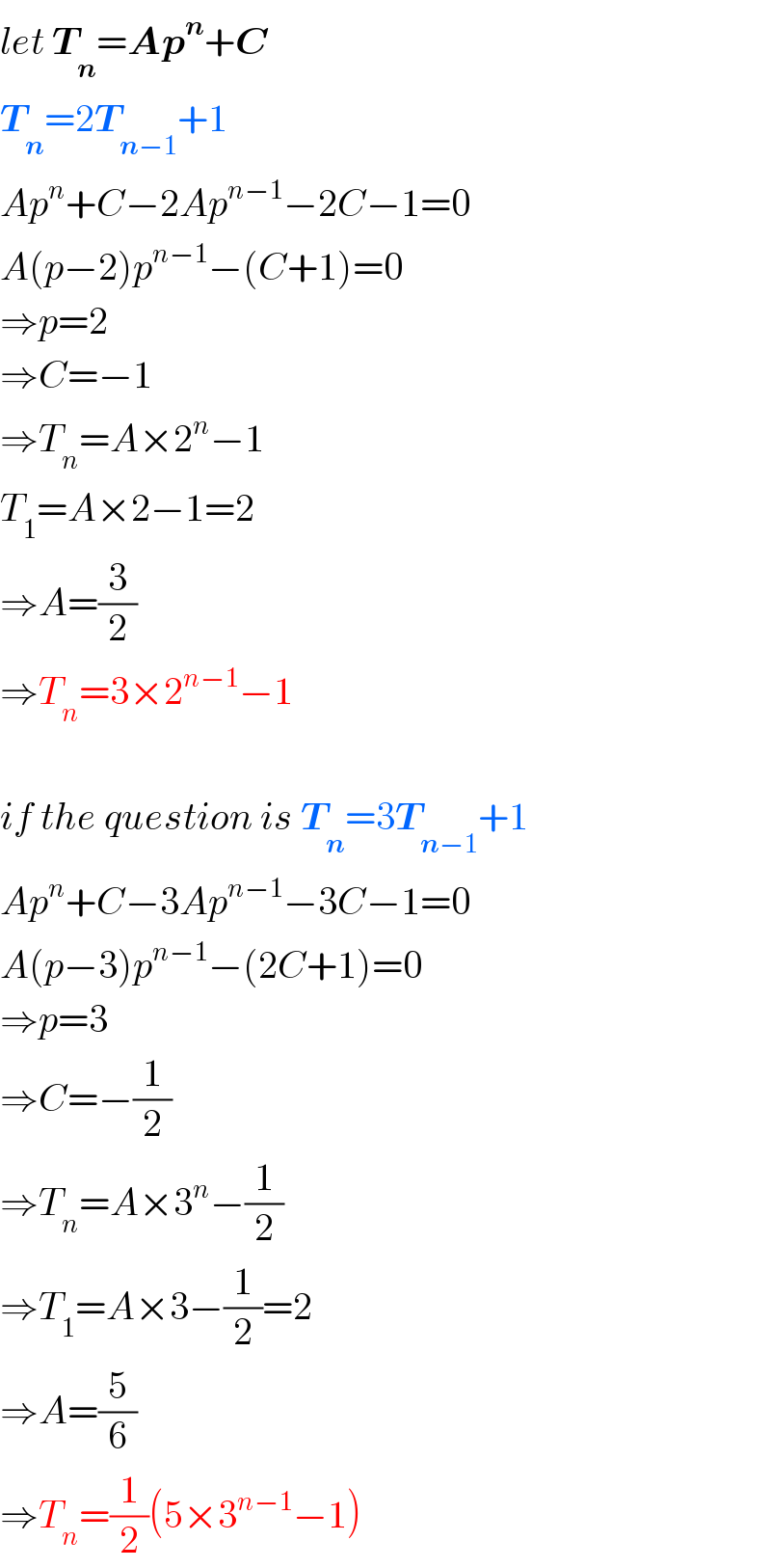
Question Number 56074 by Kunal12588 last updated on 10/Mar/19
![In a sequence if r^(th) term is given by T_r =2×T_(r−1) +1 then give it′s n^(th) term in terms of it′s 1^(st) term [Given : T_1 =2]](Q56074.png)
$${In}\:{a}\:{sequence}\:{if}\:{r}^{{th}} \:{term}\:{is}\:{given}\:{by} \\ $$$${T}_{{r}} =\mathrm{2}×{T}_{{r}−\mathrm{1}} +\mathrm{1} \\ $$$${then}\:{give}\:{it}'{s}\:{n}^{{th}} \:{term}\:{in}\:{terms}\:{of}\:\:{it}'{s}\:\mathrm{1}^{{st}} \:{term} \\ $$$$\left[{Given}\::\:\:\:\:\:{T}_{\mathrm{1}} =\mathrm{2}\right] \\ $$
Commented by maxmathsup by imad last updated on 10/Mar/19

$${we}\:{have}\:{u}_{{n}} =\mathrm{2}\:{u}_{{n}−\mathrm{1}} +\mathrm{1}\:\:\:{with}\:{u}_{\mathrm{1}} =\mathrm{2}\:\:{let}\:{find}\:{u}_{{n}} \:{interms}\:{of}\:{n} \\ $$$${let}\:{v}_{{n}} ={u}_{{n}} +\alpha\:\:{let}\:{detremine}\:\alpha\:/{v}_{{n}} {be}\:{ageom}.{sequence} \\ $$$${v}_{{n}+\mathrm{1}} ={u}_{{n}+\mathrm{1}} +\alpha\:=\mathrm{2}{u}_{{n}} +\mathrm{1}\:+\alpha\:={qv}_{{n}} ={q}\left({u}_{{n}} \:+\alpha\right)\:\Rightarrow{q}=\mathrm{2}\:{and}\:\mathrm{1}+\alpha={q}\alpha\:\Rightarrow \\ $$$$\left({q}−\mathrm{1}\right)\alpha\:=\mathrm{1}\:\Rightarrow\alpha=\mathrm{1}\:\Rightarrow{v}_{{n}} ={u}_{{n}} +\mathrm{1}\:{is}\:{geometrique}\:{let}\:{prove}\:{that} \\ $$$${v}_{{n}+\mathrm{1}} −{v}_{{n}} ={u}_{{n}+\mathrm{1}} +\mathrm{1}\:=\mathrm{2}{u}_{{n}} +\mathrm{1}+\mathrm{1}\:=\mathrm{2}\left({u}_{{n}} +\mathrm{1}\right)\:=\mathrm{2}{v}_{{n}} \:\Rightarrow \\ $$$${v}_{{n}} ={v}_{\mathrm{1}} {q}^{{n}−\mathrm{1}} \:=\mathrm{3}\:.\:\mathrm{2}^{{n}−\mathrm{1}} \:\Rightarrow{u}_{{n}} ={v}_{{n}} −\mathrm{1}\:=\mathrm{3}.\mathrm{2}^{{n}−\mathrm{1}} −\mathrm{1}. \\ $$
Commented by maxmathsup by imad last updated on 10/Mar/19

$${error}\:{of}\:{typo}\:{v}_{{n}+\mathrm{1}} ={u}_{{n}+\mathrm{1}} +\mathrm{1} \\ $$
Answered by tanmay.chaudhury50@gmail.com last updated on 10/Mar/19
![T_2 =2T_1 +1→2×2+1→2^2 +2^0 T_3 =2T_2 +1→2(2^2 +1)+1→2^3 +2^1 +2^0 T_4 =2T_3 +1→2(2^3 +2^1 +2^0 )+1→2^4 +2^2 +2^1 +1 T_5 =2T_4 +1→2(2^4 +2^2 +2^1 +1)+1→2^5 +2^3 +2^2 +2^1 +1 ... T_n =2^n +2^(n−2) +2^(n−3) +2^(n−4) +...+1←total n terms T_n =2^n +((2^(n−2) (1−(1/2^(n−1) )))/((1−(1/2))))[s=((a(1−r^n ))/((1−r)))] T_n =2^n +2^(n−1) (1−(1/2^(n−1) )) T_n =2^n +2^(n−1) −1 →it is the answer](Q56079.png)
$${T}_{\mathrm{2}} =\mathrm{2}{T}_{\mathrm{1}} +\mathrm{1}\rightarrow\mathrm{2}×\mathrm{2}+\mathrm{1}\rightarrow\mathrm{2}^{\mathrm{2}} +\mathrm{2}^{\mathrm{0}} \\ $$$${T}_{\mathrm{3}} =\mathrm{2}{T}_{\mathrm{2}} +\mathrm{1}\rightarrow\mathrm{2}\left(\mathrm{2}^{\mathrm{2}} +\mathrm{1}\right)+\mathrm{1}\rightarrow\mathrm{2}^{\mathrm{3}} +\mathrm{2}^{\mathrm{1}} +\mathrm{2}^{\mathrm{0}} \\ $$$${T}_{\mathrm{4}} =\mathrm{2}{T}_{\mathrm{3}} +\mathrm{1}\rightarrow\mathrm{2}\left(\mathrm{2}^{\mathrm{3}} +\mathrm{2}^{\mathrm{1}} +\mathrm{2}^{\mathrm{0}} \right)+\mathrm{1}\rightarrow\mathrm{2}^{\mathrm{4}} +\mathrm{2}^{\mathrm{2}} +\mathrm{2}^{\mathrm{1}} +\mathrm{1} \\ $$$${T}_{\mathrm{5}} =\mathrm{2}{T}_{\mathrm{4}} +\mathrm{1}\rightarrow\mathrm{2}\left(\mathrm{2}^{\mathrm{4}} +\mathrm{2}^{\mathrm{2}} +\mathrm{2}^{\mathrm{1}} +\mathrm{1}\right)+\mathrm{1}\rightarrow\mathrm{2}^{\mathrm{5}} +\mathrm{2}^{\mathrm{3}} +\mathrm{2}^{\mathrm{2}} +\mathrm{2}^{\mathrm{1}} +\mathrm{1} \\ $$$$... \\ $$$${T}_{{n}} =\mathrm{2}^{{n}} +\mathrm{2}^{{n}−\mathrm{2}} +\mathrm{2}^{{n}−\mathrm{3}} +\mathrm{2}^{{n}−\mathrm{4}} +...+\mathrm{1}\leftarrow{total}\:{n}\:{terms} \\ $$$${T}_{{n}} =\mathrm{2}^{{n}} +\frac{\mathrm{2}^{{n}−\mathrm{2}} \left(\mathrm{1}−\frac{\mathrm{1}}{\mathrm{2}^{{n}−\mathrm{1}} }\right)}{\left(\mathrm{1}−\frac{\mathrm{1}}{\mathrm{2}}\right)}\left[{s}=\frac{{a}\left(\mathrm{1}−{r}^{{n}} \right)}{\left(\mathrm{1}−{r}\right)}\right] \\ $$$${T}_{{n}} =\mathrm{2}^{{n}} +\mathrm{2}^{{n}−\mathrm{1}} \left(\mathrm{1}−\frac{\mathrm{1}}{\mathrm{2}^{{n}−\mathrm{1}} }\right) \\ $$$${T}_{{n}} =\mathrm{2}^{{n}} +\mathrm{2}^{{n}−\mathrm{1}} −\mathrm{1}\:\rightarrow{it}\:{is}\:{the}\:{answer} \\ $$
Commented by Kunal12588 last updated on 10/Mar/19

$${yes}\:{sir}\:\:{it}\:{is}\:{correct} \\ $$$$\mathrm{2}^{{n}−\mathrm{1}} ×\mathrm{2}+\mathrm{2}^{{n}−\mathrm{1}} −\mathrm{1}=\mathrm{3}×\mathrm{2}^{{n}−\mathrm{1}} −\mathrm{1} \\ $$
Commented by Kunal12588 last updated on 10/Mar/19

$${thank}\:{you} \\ $$
Commented by tanmay.chaudhury50@gmail.com last updated on 10/Mar/19

$${thank}\:{you}\:{sir}... \\ $$
Answered by mr W last updated on 10/Mar/19

$${let}\:\boldsymbol{{T}}_{\boldsymbol{{n}}} =\boldsymbol{{Ap}}^{\boldsymbol{{n}}} +\boldsymbol{{C}} \\ $$$$\boldsymbol{{T}}_{\boldsymbol{{n}}} =\mathrm{2}\boldsymbol{{T}}_{\boldsymbol{{n}}−\mathrm{1}} +\mathrm{1} \\ $$$${Ap}^{{n}} +{C}−\mathrm{2}{Ap}^{{n}−\mathrm{1}} −\mathrm{2}{C}−\mathrm{1}=\mathrm{0} \\ $$$${A}\left({p}−\mathrm{2}\right){p}^{{n}−\mathrm{1}} −\left({C}+\mathrm{1}\right)=\mathrm{0} \\ $$$$\Rightarrow{p}=\mathrm{2} \\ $$$$\Rightarrow{C}=−\mathrm{1} \\ $$$$\Rightarrow{T}_{{n}} ={A}×\mathrm{2}^{{n}} −\mathrm{1} \\ $$$${T}_{\mathrm{1}} ={A}×\mathrm{2}−\mathrm{1}=\mathrm{2} \\ $$$$\Rightarrow{A}=\frac{\mathrm{3}}{\mathrm{2}} \\ $$$$\Rightarrow{T}_{{n}} =\mathrm{3}×\mathrm{2}^{{n}−\mathrm{1}} −\mathrm{1} \\ $$$$ \\ $$$${if}\:{the}\:{question}\:{is}\:\boldsymbol{{T}}_{\boldsymbol{{n}}} =\mathrm{3}\boldsymbol{{T}}_{\boldsymbol{{n}}−\mathrm{1}} +\mathrm{1} \\ $$$${Ap}^{{n}} +{C}−\mathrm{3}{Ap}^{{n}−\mathrm{1}} −\mathrm{3}{C}−\mathrm{1}=\mathrm{0} \\ $$$${A}\left({p}−\mathrm{3}\right){p}^{{n}−\mathrm{1}} −\left(\mathrm{2}{C}+\mathrm{1}\right)=\mathrm{0} \\ $$$$\Rightarrow{p}=\mathrm{3} \\ $$$$\Rightarrow{C}=−\frac{\mathrm{1}}{\mathrm{2}} \\ $$$$\Rightarrow{T}_{{n}} ={A}×\mathrm{3}^{{n}} −\frac{\mathrm{1}}{\mathrm{2}} \\ $$$$\Rightarrow{T}_{\mathrm{1}} ={A}×\mathrm{3}−\frac{\mathrm{1}}{\mathrm{2}}=\mathrm{2} \\ $$$$\Rightarrow{A}=\frac{\mathrm{5}}{\mathrm{6}} \\ $$$$\Rightarrow{T}_{{n}} =\frac{\mathrm{1}}{\mathrm{2}}\left(\mathrm{5}×\mathrm{3}^{{n}−\mathrm{1}} −\mathrm{1}\right) \\ $$
